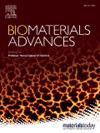Engineered PDMS microtopography: Precision regulation of tendon stem cell behavior for tendon regeneration
IF 6
2区 医学
Q2 MATERIALS SCIENCE, BIOMATERIALS
Materials Science & Engineering C-Materials for Biological Applications
Pub Date : 2025-07-13
DOI:10.1016/j.bioadv.2025.214409
引用次数: 0
Abstract
Microtopography critically regulates tendon stem cell (TSC) migration for repair, yet its precise roles remain unclear. We engineered polydimethylsiloxane (PDMS) scaffolds with precisely defined micron-scale pits and columns (diameters 7–21 μm, spacings 13–47 μm) via ultraviolet lithography and etching. High-throughput screening to promote TSC viability identified six optimal topographies: three pit-based topographies (diameters/spacings: 7 μm/47 μm, 11 μm/18 μm, 21 μm/26 μm) and three column-based topographies (diameters/spacings: 8 μm/14 μm, 13 μm/13 μm, 18 μm/18 μm). Strikingly, TSCs exhibited distinct mechanoresponses: bypassing pits while wrapping around columns, with both inducing cytoskeletal alignment (40 % reduced orientation angle, 2-fold increased polarization compared to smooth substrates). Live-cell tracking revealed migration distance correlated with filopodia density, and crucially, migration rate peaked at a specific topological area proportion (AP ≈ 0.1). Critically, pits induced filopodia branching, whereas columns triggered pseudopodial wrapping and substrate deformation, revealing topology-specific mechanotransduction pathways. This study establishes microtopography as a potent designer signal for TSC mechanobiology and provides the quantitative principle for fabricating tendon-regenerative scaffolds with tailored topological gradients, offering a novel strategy to enhance repair efficiency.
工程化PDMS微形貌:用于肌腱再生的肌腱干细胞行为的精确调控
微地形对肌腱干细胞(TSC)的修复迁移起着关键的调节作用,但其确切的作用尚不清楚。我们设计了聚二甲基硅氧烷(PDMS)支架,并通过紫外光刻和蚀刻技术精确定义了微米级凹坑和柱(直径7-21 μm,间距13-47 μm)。通过高通量筛选,确定了6种最佳形貌:3种坑状形貌(直径/间距分别为7 μm/47 μm、11 μm/18 μm、21 μm/26 μm)和3种柱状形貌(直径/间距分别为8 μm/14 μm、13 μm/13 μm、18 μm/18 μm)。引人注目的是,tsc表现出明显的机械反应:绕过凹坑而包裹在柱子周围,两者都诱导细胞骨架排列(取向角减少40%,极化比光滑底物增加2倍)。活细胞跟踪显示,迁移距离与丝足密度相关,关键是,迁移率在特定拓扑面积比例(AP≈0.1)时达到峰值。关键的是,凹坑诱导丝状伪足分支,而柱触发假伪足包裹和基底变形,揭示了拓扑特异性的机械转导途径。本研究建立了微形貌作为一种有效的TSC力学生物学设计信号,并为构建具有定制拓扑梯度的肌腱再生支架提供了定量原理,为提高修复效率提供了一种新的策略。
本文章由计算机程序翻译,如有差异,请以英文原文为准。
求助全文
约1分钟内获得全文
求助全文
来源期刊
CiteScore
17.80
自引率
0.00%
发文量
501
审稿时长
27 days
期刊介绍:
Biomaterials Advances, previously known as Materials Science and Engineering: C-Materials for Biological Applications (P-ISSN: 0928-4931, E-ISSN: 1873-0191). Includes topics at the interface of the biomedical sciences and materials engineering. These topics include:
• Bioinspired and biomimetic materials for medical applications
• Materials of biological origin for medical applications
• Materials for "active" medical applications
• Self-assembling and self-healing materials for medical applications
• "Smart" (i.e., stimulus-response) materials for medical applications
• Ceramic, metallic, polymeric, and composite materials for medical applications
• Materials for in vivo sensing
• Materials for in vivo imaging
• Materials for delivery of pharmacologic agents and vaccines
• Novel approaches for characterizing and modeling materials for medical applications
Manuscripts on biological topics without a materials science component, or manuscripts on materials science without biological applications, will not be considered for publication in Materials Science and Engineering C. New submissions are first assessed for language, scope and originality (plagiarism check) and can be desk rejected before review if they need English language improvements, are out of scope or present excessive duplication with published sources.
Biomaterials Advances sits within Elsevier''s biomaterials science portfolio alongside Biomaterials, Materials Today Bio and Biomaterials and Biosystems. As part of the broader Materials Today family, Biomaterials Advances offers authors rigorous peer review, rapid decisions, and high visibility. We look forward to receiving your submissions!

 求助内容:
求助内容: 应助结果提醒方式:
应助结果提醒方式:


